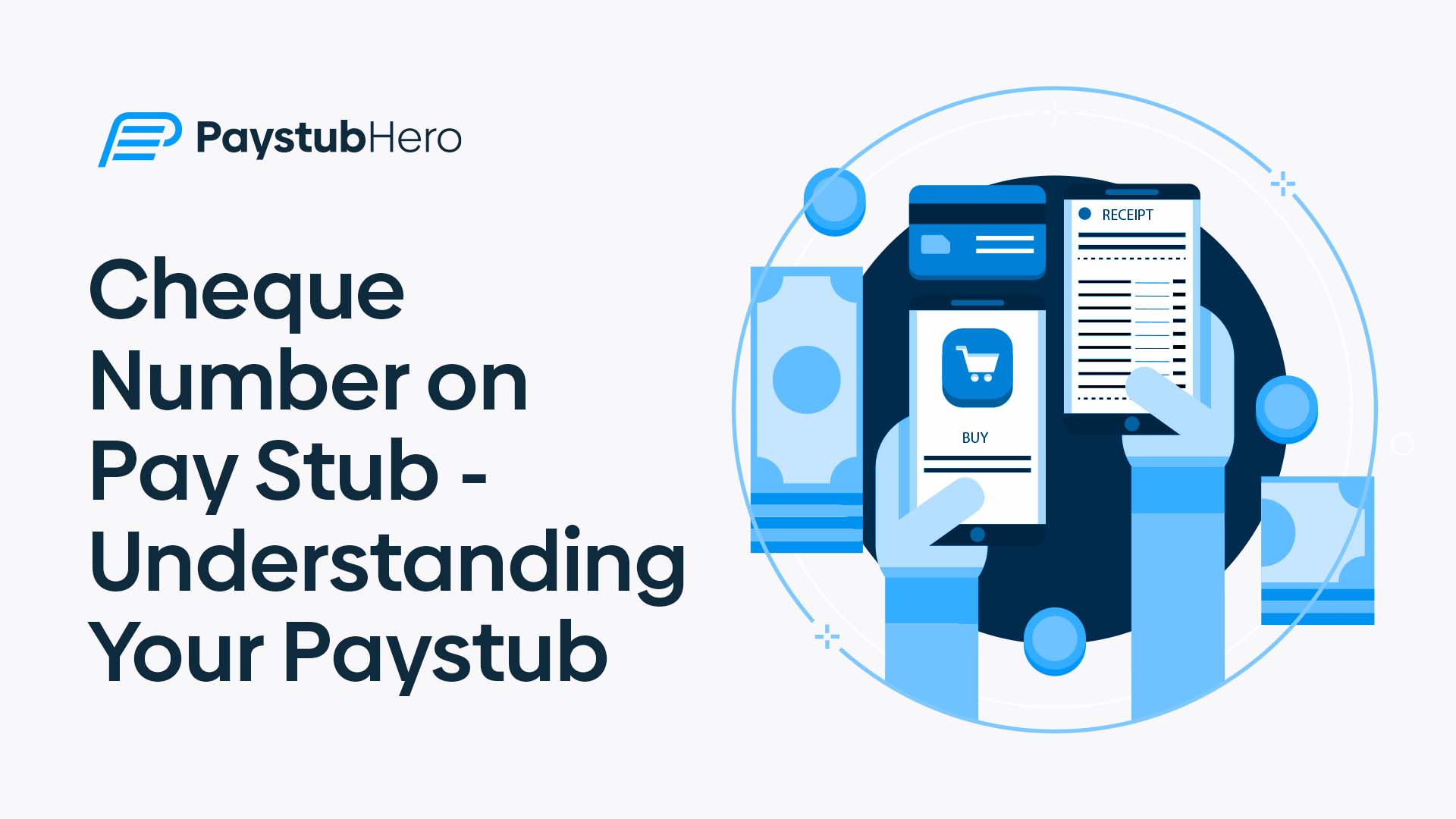Navigating your pay stub can seem like solving a complex mathematical puzzle, especially when you come across so many numbers and terms that aren’t immediately clear.
If you’re among those scratching their heads and questioning, “What is the cheque number on my pay stub?” you’re certainly not alone. Long story short, it helps with referring back or locating if you ever need those paystubs again.
A pay stub serves as a detailed summary of your earnings and deductions, and understanding each element can initially feel overwhelming.
However, it’s crucial to your financial health and can be handy when planning your budget or preparing your tax returns.
This article aims to turn the seemingly complicated into something simple and comprehensible. We’ll dive deep into the world of pay stubs and focus particularly on the importance and role of the cheque number.
Whether you’re a seasoned worker or just landed your first job, knowing how to read your pay stub is an invaluable skill. The best part? It’s easier than you might think.
Table of Contents
- Introduction: A Journey into the World of Pay Stubs
- Decoding Your Pay Stub: The Basics
- The Importance of the Cheque Number on a Pay Stub: Why it Matters
- Understanding Routing and Account Number on Your Check: More Than Just a String of Numbers
- Navigating Gross Versus Net Income on Your Pay Stub: Your Earnings Unpacked
- Tips to Understanding Your Pay Stub Better: An Insightful Guide to Your Earnings
- The Power of Paystubhero: Revolutionizing Payroll Management for Entrepreneurs and Small Businesses
- Conclusion
Decoding Your Pay Stub: A Comprehensive Guide
A pay stub is a vital document that carries significant financial information. But what really is a pay stub? Well, in its most basic form, a pay stub is a comprehensive record provided by your employer outlining every detail about your pay.
It is essentially a receipt for the work you’ve performed during a particular period and serves as a snapshot of your earnings and deductions.
Imagine your pay stub as a roadmap to your income, guiding you through the intricate details of your earnings.
It includes many elements, such as your gross income, which represents your earnings before any deductions, and your net income, which is the actual amount that lands in your bank account after all deductions like federal income tax, social security, and Medicare have been subtracted.
Among these numerous details, you’ll also stumble upon a unique identifier — the cheque number. It’s akin to a tracking number for a package, linking your pay to a specific transaction. This number comes in handy when you need to trace a payment or address a discrepancy.
Apart from the financial details, a pay stub also captures information like your name, the company name, the pay period, and sometimes even the number of hours worked, particularly in the case of hourly wage earners.
So, why is understanding your pay stub important? By thoroughly deciphering your pay stub, you can ensure that you’re being paid correctly, understand where your money is going, keep a check on errors, and plan your budget more effectively.
Moreover, a well-decoded pay stub can also serve as proof of income, helping you when applying for a loan or rental property.
As you can see, there’s more to your pay stub than just a bunch of numbers and jargon. It’s a treasure trove of important financial information, providing a clear picture of your income and deductions.
Understanding each element of it not only gives you a better handle on your personal finances but also empowers you to make informed financial decisions.
The Importance of the Cheque Number on a Pay Stub: Why it Matters
A number often overlooked on the pay stub, the cheque number, is a valuable piece of information. But why is it so important?
In the world of finance, tracking and managing transactions is vital for smooth operations and effective financial management. The cheque number serves as an integral part of this tracking process. It is a unique identifier, much like a fingerprint for your payment, that differentiates it from countless other transactions.
This unique identifier, the cheque number, acts as a beacon in the sea of financial transactions. Suppose a discrepancy, dispute, or query about a particular payment arises.
In such a scenario, you don’t have to be lost in a whirlpool of transactions to track the issue. Instead, you can use the cheque number as a reference point to trace the payment in question. This functionality can dramatically speed up the resolution process, saving you time and possibly reducing stress.
Beyond its role as a tracking tool, the cheque number also helps maintain an organized record of payments. It assists in bookkeeping and ensures the accuracy of payroll records by preventing confusion between different payments.
Furthermore, it can also serve as evidence of payment in case of a dispute or misunderstanding between an employer and an employee.
For instance, if an employee claims non-receipt of a certain payment, the cheque number can be used to confirm whether the payment was issued.
Therefore, the humble cheque number plays a significant role in keeping your financial world in order. It ensures transparency, aids in dispute resolution, and enhances the overall efficiency of financial management.
So, the next time you glance over your pay stub, take a moment to appreciate the importance of that unique cheque number. It’s a small detail with a significant impact.
Understanding Routing and Account Number on Your Check: More Than Just a String of Numbers
Regarding financial documents like checks or pay stubs, each number carries its own significance. The routing number and the account number on a check, for instance, are critical for ensuring that money moves correctly and efficiently within the vast financial network.
But what do these numbers signify, and how are they different from the cheque number on your pay stub?
At first glance, your pay stub might mirror the layout of a traditional bank check. This can sometimes confuse all these different numbers – the cheque number, the routing number, and the account number – may seem similar.
Understanding the distinct purpose and meaning behind each of these numbers is crucial to ensuring accurate financial transactions.
The routing number on a check is typically a nine-digit numerical code. It acts like a digital address for your bank, signifying your bank’s identity in the vast network of financial institutions.
This number plays an essential role when you’re processing checks or transferring money between banks. It tells the money where to go, ensuring that your funds reach the right financial institution.
On the other hand, the account number on your check represents your unique account within that bank. It’s like your financial fingerprint within the banking system. This number guides your money to the correct account within the bank once it has reached the right institution, as guided by the routing number.
Both these numbers – the routing number and the account number – are crucial for accurate money transfer. If these numbers are incorrect, your money could end up in the wrong place.
Now, you might wonder how the cheque number on your pay stub fits into this puzzle. The cheque number doesn’t participate in the transfer of money. Instead, it plays a crucial role in tracking transactions and maintaining organized financial records. It’s a unique identifier that links your pay to a specific transaction, making it easier to track payments, resolve disputes, and maintain accurate financial records.
So, when looking at your pay stub or a check, remember that each number serves a specific purpose in the grand scheme of your financial landscape.
Understanding these numbers and their roles can help you effectively navigate your finances, ensuring smooth and accurate financial transactions.
Navigating Gross Versus Net Income on Your Pay Stub: Your Earnings Unpacked
A pay stub does more than list your hours worked and the rate you’re paid. It provides an insight into your earnings, detailing two key figures: gross income and net income.
These terms can often be confusing, especially if you’re new to the world of payroll. But understanding the difference between gross and net income is fundamental to effective financial management and planning.
Your gross income, as it appears on your pay stub, represents the total amount of money you’ve earned before any deductions come into play. This figure is your raw earnings, untampered by taxes or other deductions. It could be calculated in different ways, depending on whether you’re a salaried employee, an hourly worker, or earn commission-based pay.
However, regardless of how it’s calculated, your gross income is the starting point of your earnings.
Now, what happens between your gross income and the money that eventually lands in your bank account?
The simple answer: deductions. Deductions are amounts taken out of your gross income for various reasons, including federal income tax, state taxes, social security, Medicare, health insurance, and retirement contributions, among others.
Once these deductions are subtracted from your gross income, you arrive at your net income. Also known as your take-home pay, your net income is the actual amount of money that you receive to spend, save, or invest. It’s what you’re left with after the taxman and other necessary payments have had their share.
Understanding the difference between your gross income and net income can help you manage your finances more effectively. Knowing your gross income can help you understand your earning power, while your net income gives a realistic picture of the funds available for your living expenses, savings, and discretionary spending.
Moreover, understanding these two terms also plays a vital role in income verification processes. When you’re applying for a loan, a credit card, or even a lease agreement, you might often be asked to provide your gross income.
In conclusion, your pay stub is more than just a record of your earnings. It offers a wealth of information, from the all-important cheque number to the crucial details of your income and deductions.
While it may seem a bit complicated at first, understanding the difference between gross and net income, along with other elements like the cheque number, can empower you to better manage your finances and make informed financial decisions.
Tips to Understanding Your Pay Stub Better: An Insightful Guide to Your Earnings
Understanding your pay stub can feel like learning a new language, filled with numbers and financial jargon.
However, with some practice and the right tips, you can quickly turn this complex document into a comprehensible guide to your earnings. Here are some actionable steps to help you navigate your pay stub better:
- Regularly Review Your Pay Stub: Make it a habit to review your pay stub every pay period. Ensure all the details, including the cheque number, gross income, net income, and deductions, are accurate. Regular reviews can help you spot any discrepancies and address them promptly.
- Understand Key Terms: Familiarize yourself with essential pay stub terms. Knowing the difference between gross and net income, the significance of federal income tax, and the role of the cheque number, among other things, can go a long way in helping you understand your pay stub.
- Verify Your Account Number: Always cross-check the account number on your check with your actual bank account number. This can help prevent discrepancies and ensure that your hard-earned money lands in the right place.
- Ask For Help When Needed: If you encounter a term or number you need help understanding, feel free to seek clarification. Contact your payroll department, consult a financial advisor, or use online resources to clarify your doubts. Remember, no question is too small when understanding your finances.
- Use Technology: Today, there are several tools and apps available that can help you interpret your pay stub. Use these resources to simplify the process and gain a better understanding of your income and deductions.
- Understand Your Deductions: Pay close attention to the deductions section of your pay stub. Understanding where your money is going can help you budget effectively and ensure you’re not overpaying taxes or other contributions.
- Keep Your Pay Stubs: Always keep your pay stubs for future reference. They can act as proof of income and can be useful when filing taxes, applying for loans, or for other financial matters.
Your pay stub is a window into your financial health, providing a snapshot of your earnings and deductions. With these tips, you can unlock the potential of this valuable document, empowering you to take control of your financial journey. Remember, understanding your pay stub is not just about knowing what you earn; it’s about realizing how you earn, where your money goes, and ultimately, how to manage it better.
The Power of Paystubhero: Revolutionizing Payroll Management for Entrepreneurs and Small Businesses
In the bustling realm of entrepreneurship and small businesses, every second counts. Navigating the complexities of payroll management can often seem like a daunting task.
Enter Paystubhero – an innovative online payroll software designed specifically with the needs of entrepreneurs, freelancers, small businesses, and independent contractors in mind.
Paystubhero recognizes the unique challenges faced by these individuals and businesses in accessing efficient payroll services. Traditional software platforms, such as ADP or Gusto, are often geared toward larger businesses, with pricing models and features that might not align with the needs and budgets of smaller entities.
In contrast, Paystubhero provides a more robust and simplified solution, allowing you to generate your paystubs quickly and efficiently.
The process is as easy as 1-2-3. All you need to do is enter your company and employee info, and Paystubhero handles the rest, ensuring accurate calculations and timely generation of your paystubs.
One key advantage of using Paystubhero is its affordability. It provides high-quality, professional payroll services at a fraction of the cost of traditional payroll platforms.
With Paystubhero, entrepreneurs, freelancers, and small businesses can access premium payroll services without stretching their budget.
Moreover, Paystubhero’s software interface is user-friendly, making payroll management a hassle-free process. It takes the stress out of payroll, allowing you to focus on what you do best – growing your business.
Above all, Paystubhero offers you peace of mind. It ensures that you and your employees receive accurate, timely, and clear paystubs. You no longer have to worry about decoding complex financial jargon or getting lost in a sea of numbers.
Paystubhero presents all the necessary information, including the cheque number, gross income, net income, and deductions, in an easily digestible format.
So, whether you’re a seasoned entrepreneur, a freelancer on the rise, a growing small business, or an independent contractor, Paystubhero can help you take control of your payroll management, making the process seamless, straightforward, and efficient.
Harness the power of Paystubhero and experience a new way of managing your payroll.
At the end of the day, Paystubhero isn’t just a payroll software; it’s a powerful tool that empowers you to focus more on your business and less on payroll. Discover the ease and efficiency of Paystubhero today, and transform your payroll management experience.
Join us at Paystubhero, where we believe that managing your payroll should be as simple as running your business. Start your journey with us today, and let us handle the complexities of payroll, so you can focus on what truly matters – growing your business. Sign up now.
Conclusion
In conclusion, understanding your pay stub, including the cheque number, is crucial for effective financial management. With tools like Paystubhero, the process becomes significantly easier, putting you in control of your payroll.
Ready to simplify your payroll process? Start using Paystubhero today! It’s as easy as 1-2-3.
Frequent Asked Questions
Do all paystubs have a check number?
Yes, typically, all paystubs have a check number. It’s used for tracking and maintaining organized financial records.
Is it a paycheck or pay Cheque?
Both terms are correct but are used in different regions. In the United States, it’s commonly referred to as a ‘paycheck,’ while in the United Kingdom and other Commonwealth countries, ‘pay Cheque’ is used more frequently.
What do the abbreviations on my paystub mean?
The abbreviations on your paystub typically represent various deductions and contributions. For example, “FICA” stands for Federal Insurance Contributions Act (Social Security and Medicare taxes), while “FIT” often stands for Federal Income Tax. If you’re unsure about a specific abbreviation, it’s best to consult with your payroll department or use an online resource for clarification.








